SUZUKI JIMNY 2020 Owner's Manual
Manufacturer: SUZUKI, Model Year: 2020, Model line: JIMNY, Model: SUZUKI JIMNY 2020Pages: 421, PDF Size: 6.35 MB
Page 21 of 421
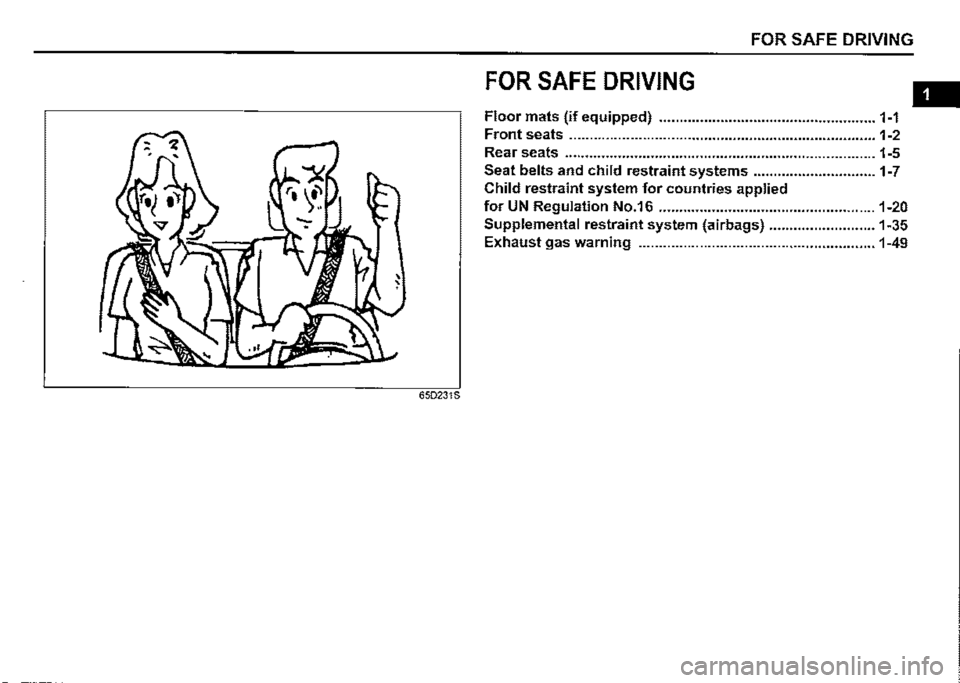
FOR SAFE DRIVING
FOR SAFE DRIVING
-Floor mats (if equipped) ..................................................... 1-1
Front seats ........................................................................... 1-2
Rear seats ............................................................................ 1-5
Seat belts and child restraint systems .............................. 1-7
Child restraint system for countries applied
for UN Regulation No.16 ..................................................... 1-20
Supplemental restraint system (airbags) .......................... 1-35
Exhaust gas warning .......................................................... 1-49
Page 22 of 421
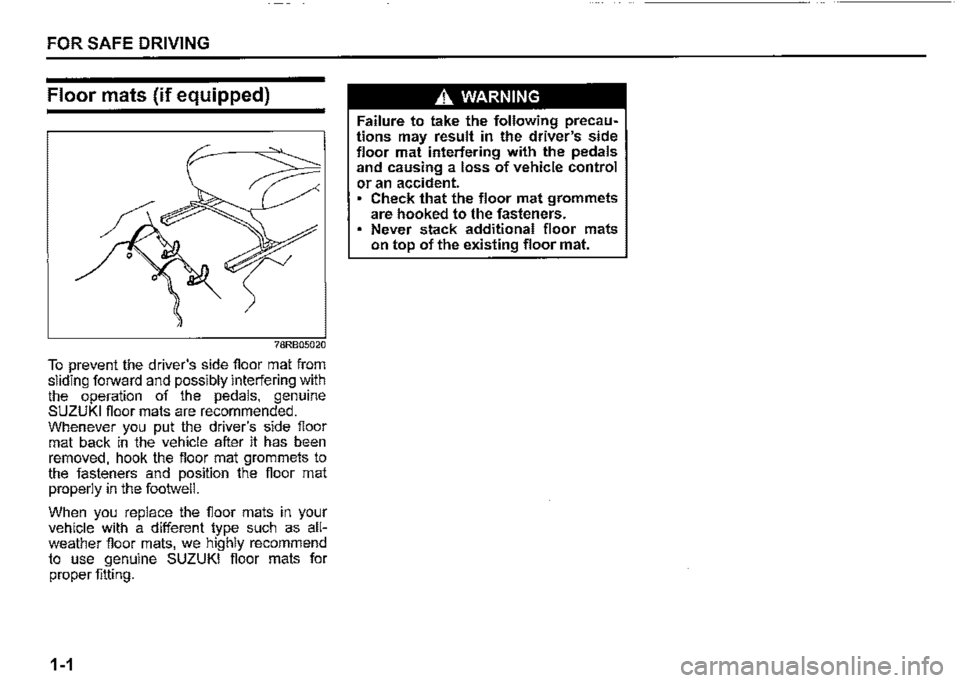
FOR SAFE DRIVING
Floor mats (if equipped)
78RB05020
To prevent the driver's side floor mat from sliding forward and possibly interfering with the operation of the pedals, genuine SUZUKI floor mats are recommended. Whenever you put the driver's side floor mat back in the vehicle after it has been removed, hook the floor mat grommets to the fasteners and position the floor mat properly in the footwell.
When you replace the floor mats in your vehicle with a different type such as allweather floor mats, we highly recommend to use genuine SUZUKI floor mats for proper fitting.
1-1
A. WARNING
Failure to take the following precautions may result in the driver's side floor mat interfering with the pedals and causing a loss of vehicle control or an accident. Check that the floor mat grommets are hooked to the fasteners. Never stack additional floor mats on top of the existing floor mat.
Page 23 of 421
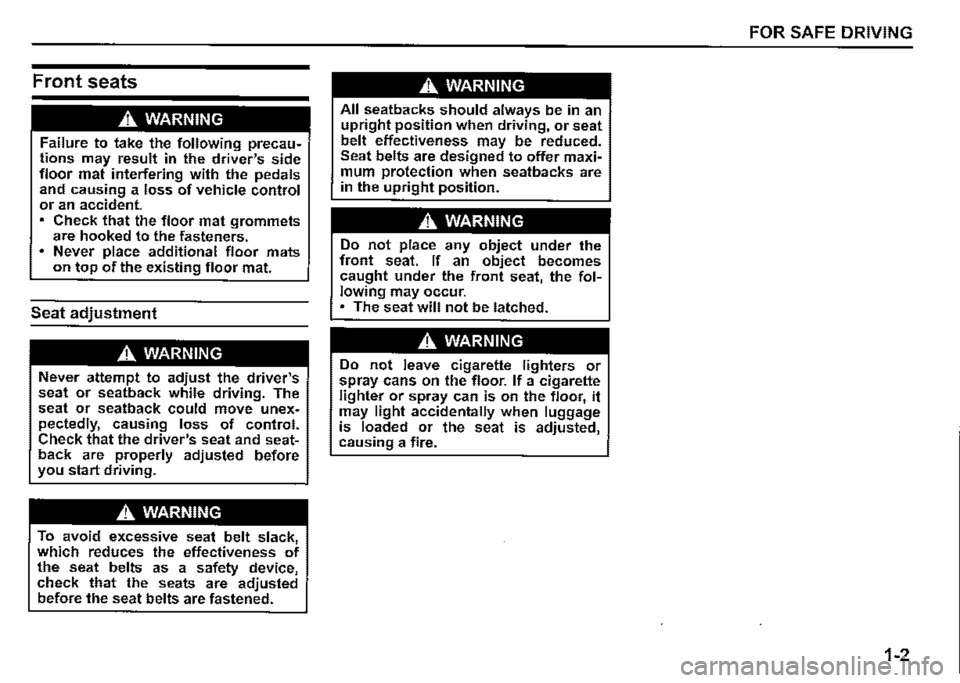
Front seats
A WARNING
Failure to take the following precautions may result in the driver's side floor mat interfering with the pedals and causing a loss of vehicle control or an accident. Check that the floor mat grommets are hooked to the fasteners. Never place additional floor mats on top of the existing floor mat.
Seat adjustment
A WARNING
Never attempt to adjust the driver's seat or seatback while driving. The seat or seatback could move unexpectedly, causing loss of control. Check that the driver's seat and seatback are properly adjusted before you start driving.
A WARNING
To avoid excessive seat belt slack, which reduces the effectiveness of the seat belts as a safety device, check that the seats are adjusted before the seat belts are fastened.
A WARNING
All seatbacks should always be in an upright position when driving, or seat belt effectiveness may be reduced. Seat belts are designed to offer maximum protection when seatbacks are in the upright position.
A WARNING
Do not place any object under the front seat. If an object becomes caught under the front seat, the following may occur. • The seat will not be latched.
A WARNING
Do not leave cigarette lighters or spray cans on the floor. If a cigarette lighter or spray can is on the floor, it may light accidentally when luggage is loaded or the seat is adjusted, causing a fire.
FOR SAFE DRIVING
1-2
Page 24 of 421
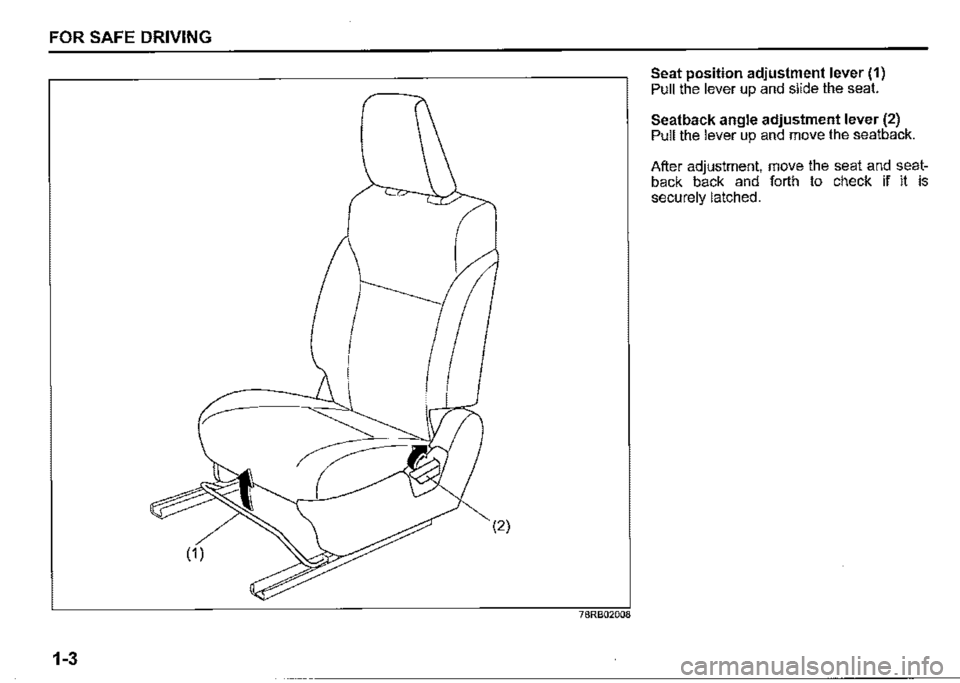
FOR SAFE DRIVING
78RB02008
1-3
Seat position adjustment lever (1) Pull the lever up and slide the seat.
Seatback angle adjustment lever (2) Pull the lever up and move the seatback.
After adjustment, move the seat and seatback back and forth to check if it is securely latched.
Page 25 of 421
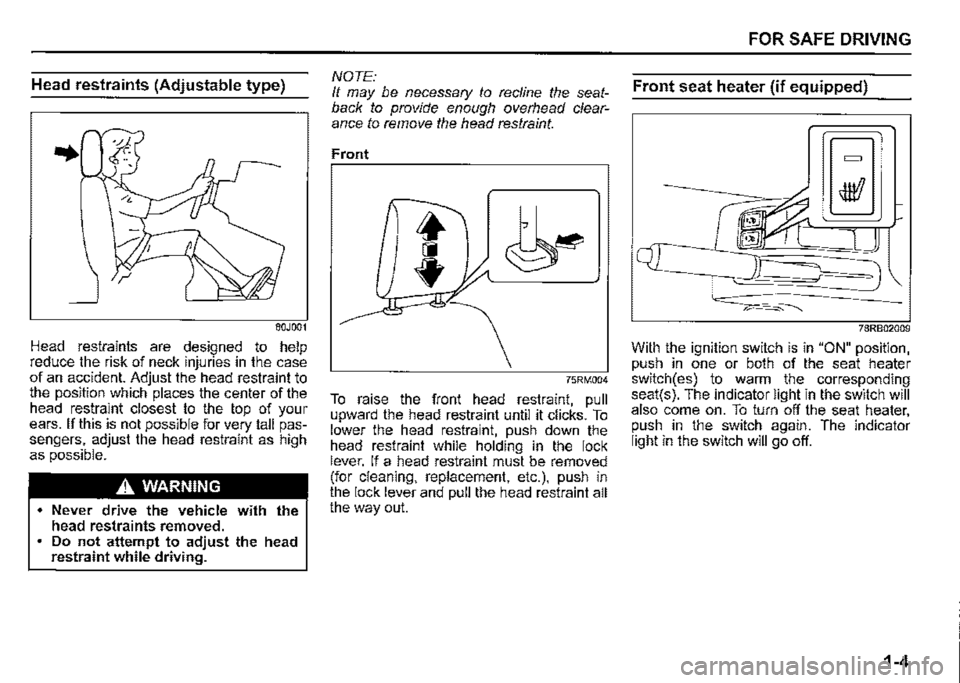
Head restraints (Adjustable type)
80J001
Head restraints are designed to help reduce the risk of neck injuries in the case of an accident. Adjust the head restraint to the position which places the center of the head restraint closest to the top of your ears. If this is not possible for very tall passengers, adjust the head restraint as high as possible.
A WARNING
• Never drive the vehicle with the head restraints removed. Do not attempt to adjust the head restraint while driving.
NOTE: It may be necessary to recline the seatback to provide enough overhead clearance to remove the head restraint.
Front
75RM004
To raise the front head restraint, pull upward the head restraint until it clicks. To lower the head restraint, push down the head restraint while holding in the lock lever. If a head restraint must be removed (for cleaning, replacement, etc.), push in the lock lever and pull the head restraint all the way out.
FOR SAFE DRIVING
Front seat heater (if equipped)
78RB02009
With the ignition switch is in "ON" position, push in one or both of the seat heater switch(es) to warm the corresponding seat(s). The indicator light in the switch will also come on. To turn off the seat heater, push in the switch again. The indicator light in the switch will go off.
1-4
Page 26 of 421
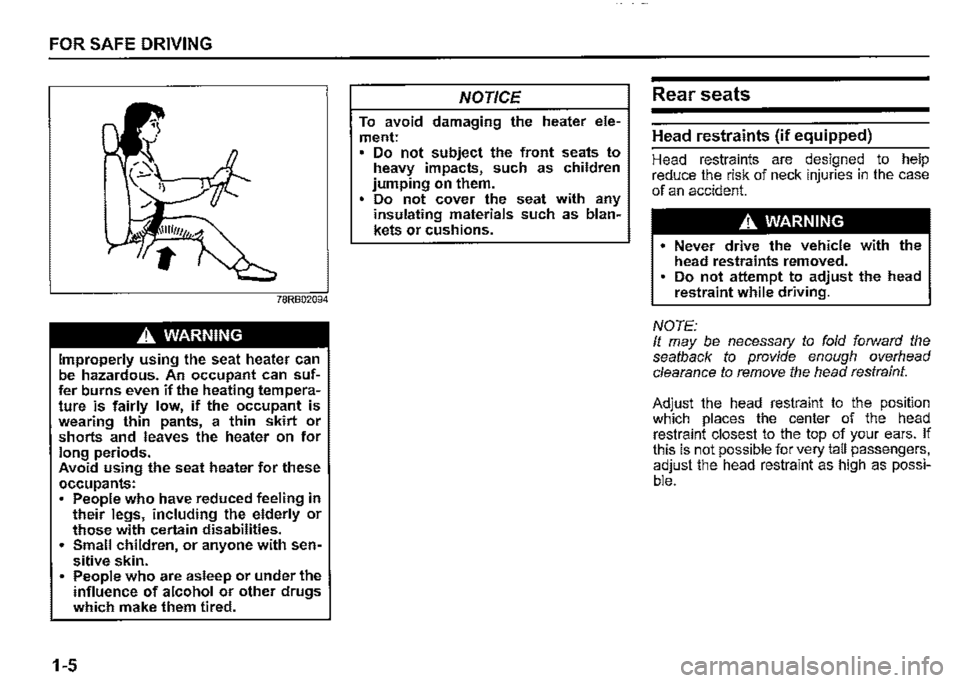
FOR SAFE DRIVING
A WARNING
Improperly using the seat heater can be hazardous. An occupant can suffer burns even if the heating temperature is fairly low, if the occupant is wearing thin pants, a thin skirt or shorts and leaves the heater on for long periods. Avoid using the seat heater for these occupants: People who have reduced feeling in their legs, including the elderly or those with certain disabilities. • Small children, or anyone with sensitive skin. • People who are asleep or under the influence of alcohol or other drugs which make them tired.
1-5
NOTICE
To avoid damaging the heater element: • Do not subject the front seats to heavy impacts, such as children jumping on them. Do not cover the seat with any insulating materials such as blankets or cushions.
Rear seats
Head restraints (if equipped)
Head restraints are designed to help reduce the risk of neck injuries in the case of an accident.
A WARNING
Never drive the vehicle with the head restraints removed. Do not attempt to adjust the head restraint while driving.
NOTE: It may be necessary to fold forward the seatback to provide enough overhead clearance to remove the head restraint.
Adjust the head restraint to the position which places the center of the head restraint closest to the top of your ears. If this is not possible for very tall passengers, adjust the head restraint as high as possible.
Page 27 of 421
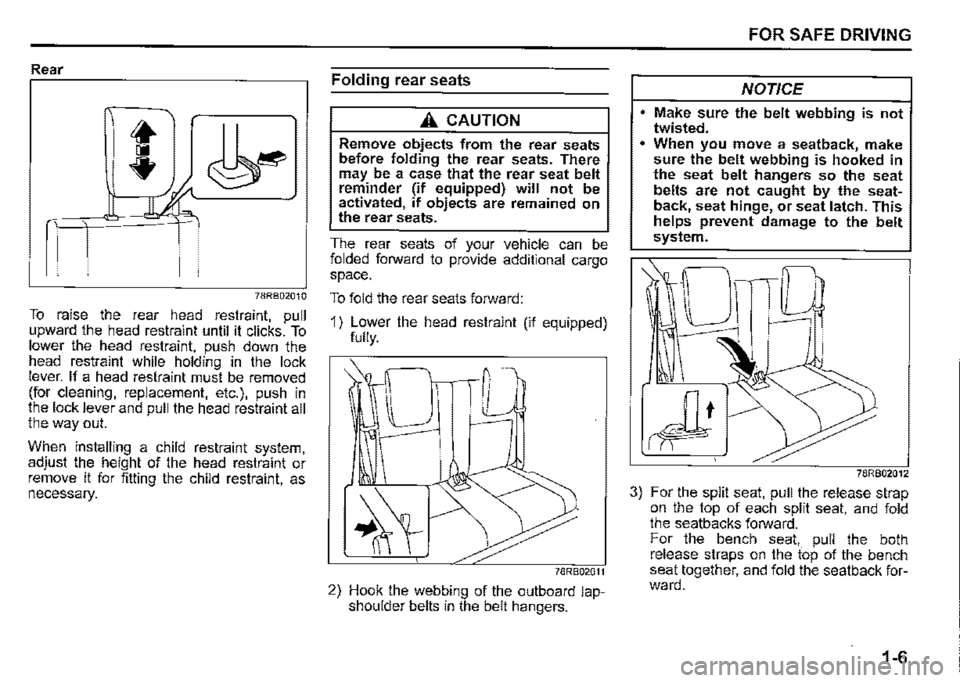
Rear
t
~~
• II ,
78RB02010
To raise the rear head restraint, pull upward the head restraint until it clicks. To lower the head restraint, push down the head restraint while holding in the lock lever. If a head restraint must be removed (for cleaning, replacement, etc.), push in the lock lever and pull the head restraint all the way out.
When installing a child restraint system, adjust the height of the head restraint or remove it for fitting the child restraint, as necessary.
Folding rear seats
A CAUTION
Remove objects from the rear seats before folding the rear seats. There may be a case that the rear seat belt reminder (if equipped) will not be activated, if objects are remained on the rear seats.
The rear seats of your vehicle can be folded forward to provide additional cargo space.
To fold the rear seats forward:
1) Lower the head restraint (if equipped) fully.
2) Hook the webbing of the outboard lapshoulder belts in the belt hangers.
FOR SAFE DRIVING
NOTICE
Make sure the belt webbing is not twisted. • When you move a seatback, make sure the belt webbing is hooked in the seat belt hangers so the seat belts are not caught by the seatback, seat hinge, or seat latch. This helps prevent damage to the belt system.
78RB02012
3) For the split seat, pull the release strap on the top of each split seat, and fold the seatbacks forward. For the bench seat, pull the both release straps on the fop of the bench seat together, and fold the seatback forward.
1-6
Page 28 of 421
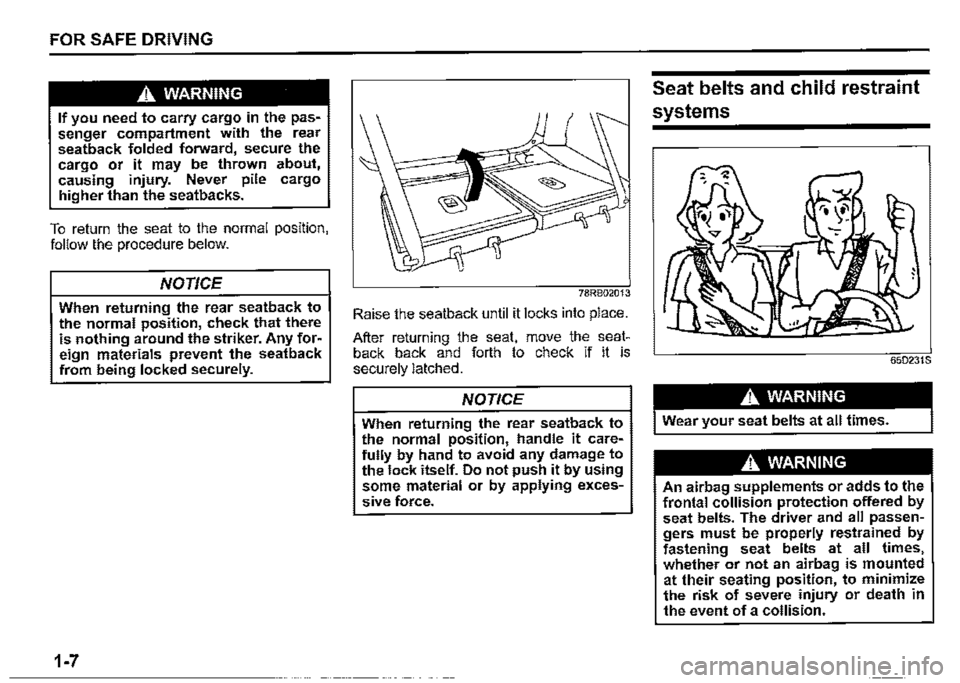
FOR SAFE DRIVING
A. WARNING
If you need to carry cargo in the passenger compartment with the rear seatback folded forward, secure the cargo or it may be thrown about, causing injury. Never pile cargo higher than the seatbacks.
To return the seat to the normal position,
follow the procedure below.
NOTICE
When returning the rear seatback to the normal position, check that there is nothing around the striker. Any foreign materials prevent the seatback from being locked securely.
1-7
78RB02013
Raise the seatback until it locks into place.
After returning the seat, move the seatback back and forth to check if it is securely latched.
NOTICE
When returning the rear seatback to the normal position, handle it carefully by hand to avoid any damage to the lock itself. Do not push it by using some material or by applying exces
sive force.
Seat belts and child restraint
systems
650231S
A. WARNING
An airbag supplements or adds to the frontal collision protection offered by seat belts. The driver and all passengers must be properly restrained by fastening seat belts at all times, whether or not an airbag is mounted at their seating position, to minimize the risk of severe injury or death in the event of a collision.
Page 29 of 421
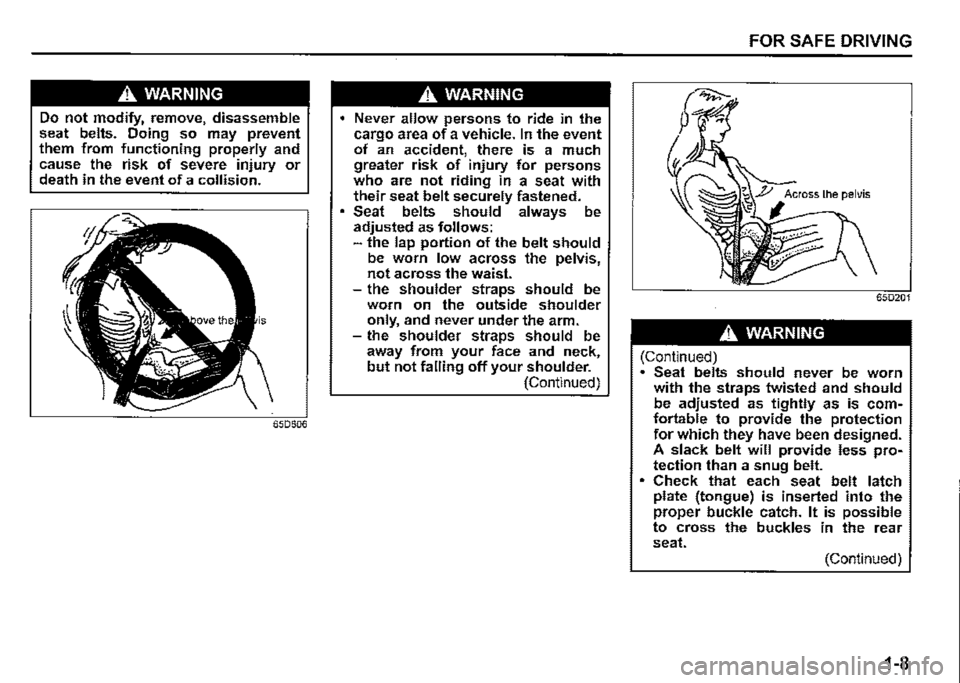
A WARNING
Do not modify, remove, disassemble seat belts. Doing so may prevent them from functioning properly and cause the risk of severe injury or death in the event of a collision.
A WARNING
Never allow persons to ride in the cargo area of a vehicle. In the event of an accident, there is a much greater risk of injury for persons who are not riding in a seat with their seat belt securely fastened. Seat belts should always be adjusted as follows: -the lap portion of the belt should be worn low across the pelvis, not across the waist. -the shoulder straps should be worn on the outside shoulder only, and never under the arm. -the shoulder straps should be away from your face and neck, but not falling off your shoulder. (Continued)
FOR SAFE DRIVING
65D201
A WARNING
(Continued) • Seat belts should never be worn with the straps twisted and should be adjusted as tightly as is comfortable to provide the protection for which they have been designed. A slack belt will provide less protection than a snug belt. Check that each seat belt latch plate (tongue) is inserted into the proper buckle catch. It is possible to cross the buckles in the rear seat. (Continued)
1-8
Page 30 of 421
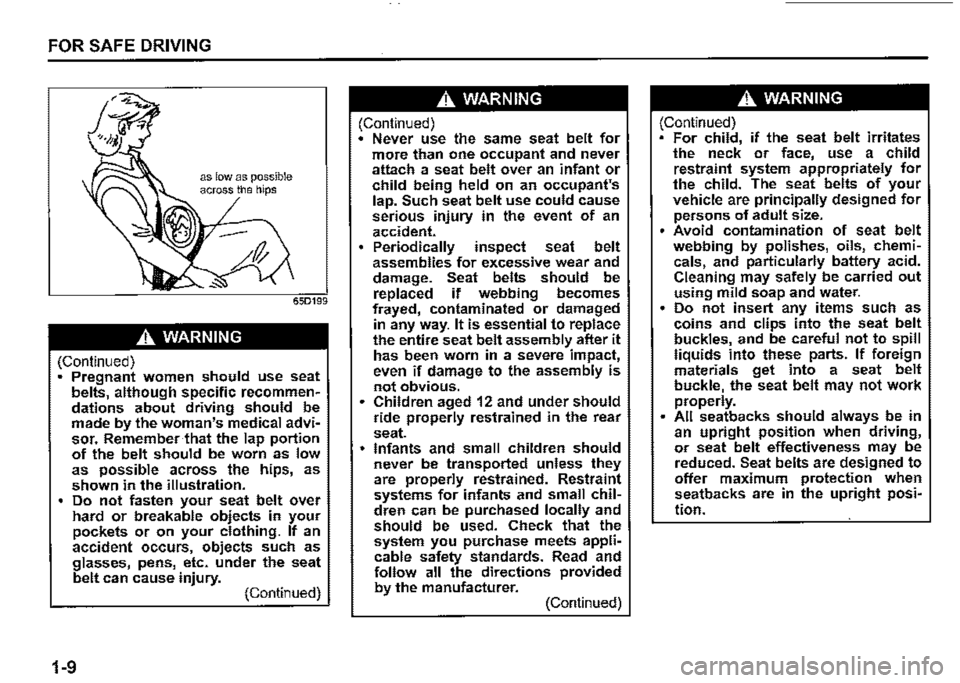
FOR SAFE DRIVING
A. WARNING
(Continued) Pregnant women should use seat belts, although specific recommendations about driving should be made by the woman's medical advi• sor. Remember that the lap portion of the belt should be worn as low as possible across the hips, as shown in the illustration. Do not fasten your seat belt over hard or breakable objects in your pockets or on your clothing. If an accident occurs, objects such as glasses, pens, etc. under the seat belt can cause injury. (Continued)
1-9
A. WARNING
(Continued) • Never use the same seat belt for more than one occupant and never attach a seat belt over an infant or child being held on an occupant's lap. Such seat belt use could cause serious injury in the event of an accident. Periodically inspect seat belt assemblies for excessive wear and damage. Seat belts should be replaced if webbing becomes frayed, contaminated or damaged in any way. It is essential to replace the entire seat belt assembly after it has been worn in a severe impact, even if damage to the assembly is not obvious. Children aged 12 and under should ride properly restrained in the rear seat. Infants and small children should never be transported unless they are properly restrained. Restraint systems for infants and small chil• dren can be purchased locally and should be used. Check that the system you purchase meets appli• cable safety standards. Read and follow all the directions provided by the manufacturer. (Continued)
A. WARNING
(Continued) For child, if the seat belt irritates the neck or face, use a child restraint system appropriately for the child. The seat belts of your vehicle are principally designed for persons of adult size. Avoid contamination of seat belt webbing by polishes, oils, chemi• cals, and particularly battery acid. Cleaning may safely be carried out using mild soap and water. • Do not insert any items such as coins and clips into the seat belt buckles, and be careful not to spill liquids into these parts. If foreign materials get into a seat belt buckle, the seat belt may not work properly. All seatbacks should always be in an upright position when driving, or seat belt effectiveness may be reduced. Seat belts are designed to offer maximum protection when seatbacks are in the upright posi•
tion.